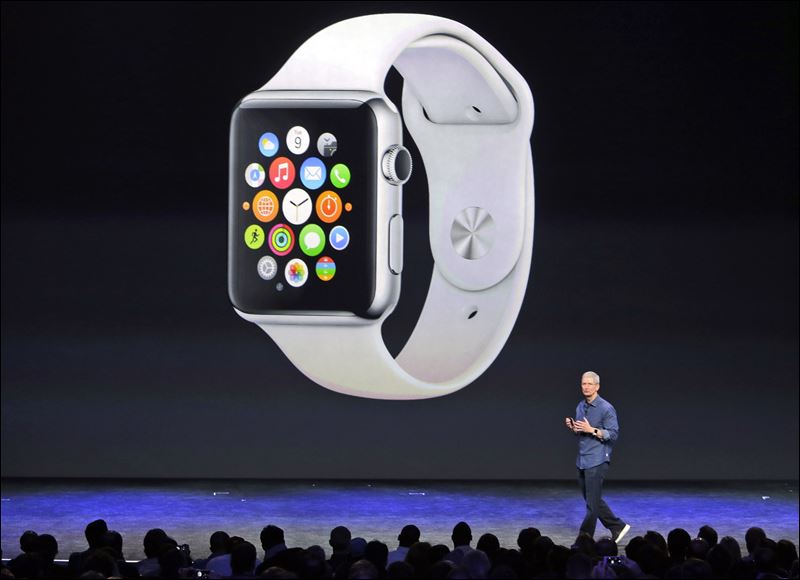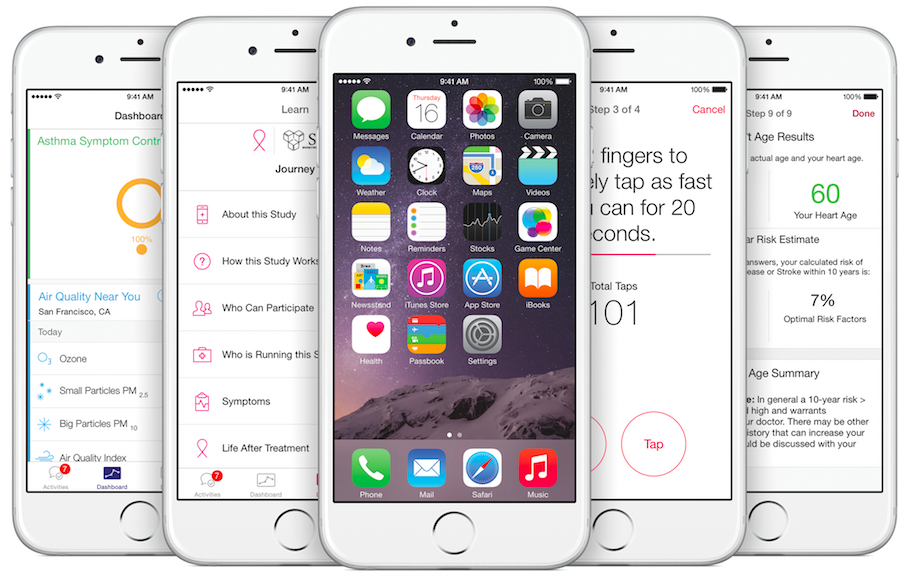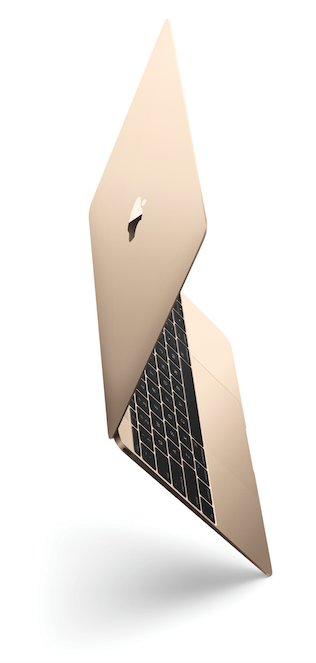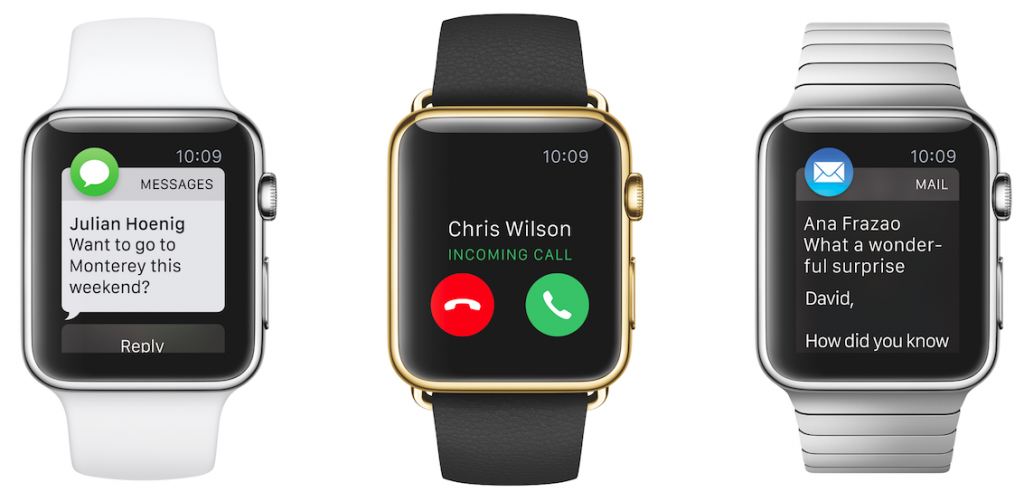
On Monday, Apple CEO Tim Cook hosted the company’s latest keynote dubbed “Spring Forward” and it packed quite a punch. Everyone was expecting more details about the anticipated Apple Watch–release date and pricing was finally made known–but before getting to all that, Cook announced an exciting launch with HBO, he introduced a forward-thinking platform called HealthKit that aims to support the medical field in new and exciting ways, and a brand new MacBook packed with all kinds of cool technology made its debut. For all the details, skip after the break.

HBO NOW + Apple TV
Tim Cook kicked off today’s keynote with a major announcement regarding one Apple’s entertainment partners. The Apple head introduced the premium cable network’s CEO Richard Plepler on stage to formally announce and detail HBO NOW. It’s a standalone streaming service that allows customers to access all of HBO’s original programming as well as its collection of Hollywood movies, documentaries, sports, and exclusive comedy specials for a monthly fee of $14.99. If you’re a cord-cutter, this is huge; HBO NOW does not require a cable or satellite subscription. All you need is a broadband connection. When HBO NOW launches in April, it will do so exclusively on Apple devices including iPhone, iPad, iPod touch, and of course, Apple TV. If you sign up for the service on an Apple device at launch, HBO will grant you a 30-day introductory free trial period. Though Plepler would not disclose an exact launch date for HBO NOW, he promised customers will be able to sign up for it in time for the season 5 premiere of Game of Thrones which debuts April 12. He closed his presentation with a brand new look at the highly anticipated new season.
Update: According to Engadget, Apple has a three-month exclusivity window with HBO. Once that ends, you will likely start to see other companies like Google and Amazon (and even HBO itself) offering up HBO NOW. Also, note that the service will work on PCs and Macs in browser at hbonow.com, but in order to actually sign up for it, you must do so from an Apple device during the aforementioned exclusive launch window.
Cook concluded this segment of the keynote by shredding $30 off the price of Apple TV, dropping it from $99 to $69. The new price takes effect immediately. Any word on when we might expect Apple’s full-on TV revolution to take place? Unfortunately, no, but Cook teased this: “We’ll reinvent the way you watch television. And this is just the beginning.” The company’s sold 25 million ATV units and counting.

ResearchKit
Apple spent a solid chunk of time today about health. The company’s sold 700 million iPhones to date, and then it wants to turn them into a medical research tool. Enter HealthKit, an open source software framework designed for such research, “helping doctors and scientists gather data more frequently and more accurately from participants using iPhone apps.” Apps built with HealthKit can be used to better understand diseases and, ultimately, help prevent and battle them. The first five HealthKit-supported apps, available today in the App Store, target asthma, breast cancer, cardiovascular disease, diabetes, and Parkinson’s disease. Per a press release, here’s a description of the app that tackles Parkinson’s (pictured above):
Developed by Sage Bionetworks and the University of Rochester, the Parkinson mPower app helps people living with Parkinson’s disease track their symptoms by recording activities using sensors in iPhone. These activities include a memory game, finger tapping, speaking and walking. Activity and survey data from your phone are combined with data from many other participants to fuel Parkinson’s research at a scale never before possible, making this the world’s largest and most comprehensive study of this disease.
Apple’s always been upfront about privacy, especially when it comes to sharing such personal information like this. Participation in studies is completely up to the user, and users have complete control over how data is shared. And of course, Apple does not see nor collect your data.
ResearchKit is available next month.

MacBook
The long-rumored newly designed 12-inch MacBook was finally unveiled today. Apple’s calling it “the new MacBook” and it will live amongst the company’s other portable laptop offerings, the MacBook Air and MacBook Pro. The new MacBook is the thinnest and lightest MacBook ever made measuring 13.1 mm thin (that’s 24 percent thinner than the 11-inch Air) and weighing just 2 pounds. The 12-inch, 2304 x 1440 resolution Retina display packs over 3.3 million pixels with a 16:10 aspect ratio. Measuring 0.88 mm thin, this is the thinnest Mac display yet. Apple’s also calling this machine “the world’s most energy-efficient notebook;” in fact, it uses 30 percent less energy than existing Mac notebook Retina displays.
In addition to the stunning display, the new MacBook’s overall build is quite a feat. The all-metal unibody enclosure manages to pack a newly designed full-size keyboard, an enhanced multi-touch trackpad, a breakthrough battery layout, and the most compact logic board ever. Let’s dive into each area now. The new keyboard is 34 percent thinner than before and its keys take advantage of an Apple-designed butterfly mechanism that essentially provides for more stable, precise, and accurate key strokes. Also, every key is now individually backlit with its own single LED for enhanced and unified illumination.
The new Force Touch trackpad replaces the “diving board” design from older MacBook models with a completely pressure-sensitive design which allows you to type anywhere on it to register a click. Users will have the option to customize the feel of the trackpad by changing the amount of pressure needed to register each click. Four built-in force sensors provide haptic feedback, so now you can “feel” what you touch with slight vibrations emitting from the trackpad. This is powered by Apple’s Taptic Engine, the same one featured inside the Watch. Last, there’s a new gesture called Force Click; since the new trackpad can sense the force of a press, you can click and deep press to enable new tasks. For example, click and deep press over an address in Safari to bring up its location in Maps. Or Force Click over a highlighted word to discover more about it at Wikipedia. Cool stuff like that.
All of these new specs and functionality are neat, but I’ve saved the most impressive bit for last. Apple’s incredibly talented engineers were able to miniaturize the logic board to make it fit snug in the new unibody case. The company’s tiniest logic board ever is a whopping 67 percent smaller than the one found inside the 11-inch Air. How’d they do it? They removed the fan. Yep, the new MacBook is the first fanless Mac notebook with no vents or moving parts; and thanks to that it operates silently. And what’d they do with the leftover space? They filled it with batteries, of course! A new terraced battery design essentially layers individual battery sheets on top of each other along the contoured insides of the notebook. Apple claims all-day battery life with up to 9 hours of web browsing and up to 10 hours of video playbook.
Now, since this MacBook is so damn thin, they couldn’t even manage to fit regular-sized USB ports! In fact, the new MacBook only features one single port (well, if you don’t include the headphone jack). It’s a next-generation USB-C port which is a new industry standard; it’s one-third the size of a regular USB port. In addition to charging the notebook, it can be used to power all kinds of connections including USB, DisplayPort, HDMI, and VGA for data transfers and video output. But with its built-in 802.11ac Wi-Fi and Bluetooth 4.0 wireless protocols, Apple hopes its owners will adopt a cable-free mindset and take advantage of features such as AirPlay and AirDrop for sharing data and content. That’s Apple’s vision of the future, anyway. If you’re not quite prepared to live like that yet, Apple’s got you covered; these VGA and Digital AV Multiport Adapters, at $79 apiece, will help you out with peripheral connectivity.
The new MacBook starts at $1299 and that base SKU will get you a 1.1GHz dual-core Intel Core M processor (with Turbo Boost speeds up to 2.4GHz), Intel HD Graphics 5300, 8GB of memory, and 256GB of flash storage. An upgraded SKU costs $1599 and this one beefs up the processor to 1.2GHz (with Turbo Boost speeds up to 2.6GHz) and the SDD to 512GB. It ships starting Friday, April 10. Oh, and it comes in three new finishes to match its smaller sibling, the iPhone: silver, gold, and space grey. Check ’em out at the Apple Online Store.
One more thing. Today Apple also updated its other MacBooks with better performance and some functionality upgrades. The 13-inch MacBook Pro with Retina display and the 11 and 13-inch MacBook Airs now pack fifth-gen Intel Core processors and two times faster flash. The MBP gets updated Intel Iris Graphics 6100, longer battery life, and the all-new Force Touch trackpad that’s featured on the new MacBook as described above. The Airs get updated Intel HD Graphics 6000 and Thunderbolt 2. Check out the new Air and Pro configurations at the provided links; they ship today.

Apple Watch
So today’s “Apple Watch” event ended up being overshadowed by other product announcements, including HBO’s cord-cutting initiative and of course the shiny new MacBook. If you were hoping for some revelatory news concerning Apple’s new product category device, you’ll be a sad puppy today. But that doesn’t mean excitement wasn’t in the air when Cook and co. put the final touches on Watch’s imminent launch.
Before laying out availability and price, I can’t go without at least touching upon Cook’s major talking points. Apple Watch is an “incredibly accurate and customizable timepiece;” it’s an intimate and immediate communication device;” and it’s a groundbreaking health and fitness companion.” Cook laid all this out and more during Watch’s initial unveiling back in September. Customizable watch faces and configurations, Glances, Notifications, the Digital Crown, sending sketches and haptic patterns and your heartbeat’s rhythm via Digital Touch, receiving and sending text messages via dictation, the Activity app–these features have already been covered. New abilities covered at today’s keynote? Watch does have a built-in microphone and speakerphone and these enable calls to be made and received directly from the wrist wear. Also, Siri is onboard and you can either tap the side button under the Digital Crown or speak aloud “Hey Siri” to activate her. Apple Pay was demonstrated today as well; simply place your Watch in close proximity to a compatible NFC payment terminal and slight haptic feedback will confirm payment. With typical use, Apple claims 18-hour all-day battery life.
And don’t worry, third party support is here, too. Since WatchKit SDK was released in November, developers have created thousands of apps specifically for the Watch, says Apple. Uber, Shazam, and Instagram were demoed on stage, and they worked without a hitch just as you’d expect. A cool app from Alarm.com was also demonstrated. An Apple exec remotely controlled his home garage to allow his locked out daughter entry inside; a live feed of the garage was displayed on his watch and the tap of a button opened the door. If this isn’t the future, then I don’t know what is! How does one get these apps onto Watch? Apple outed iOS 8.2 today, and with it comes a new Apple Watch app for iPhone. There you can browse and download Watch-specific apps from the new Apple Watch App Store. 8.2 is available for download now, but don’t expect to find much inside the Watch app; it will surely start to populate as we get closer to Watch’s launch.
Here’s the information you’ve been patiently waiting for: Apple Watch releases April 24 in the US, Australia, Canada, China, France, Germany, Hong Kong, Japan, and the UK. On April 10, it will be available for preview, try-on by appointment at Apple retail stores, and you can preorder starting this day as well at Apple’s online store. In addition to being sold at Apple retail stores and Apple online, Watch will also sell at select department stores and at boutiques in major cities across the world.
There are three distinct collections, many band options, and two different sizes: 38 mm and 42 mm. Apple Watch Sport, with its lightweight anodized aluminum case, starts at $349 for the 38 mm size; the 42 mm size will go for $399. Apple Watch, with its highly polished stainless steel case, starts at $549 and goes up to $1099 in price. Apple Watch Edition, with its custom rose or yellow 18-karat gold alloys, starts at $10,000. Explore the various collections and configurations at the provided links. Bands will also be sold separately, and you can explore those here.
That about sums it all up! If you’re a fan of fancy visuals come to life, be sure to check out the in-depth product videos embedded below.
Wow… The new MacBook!! I’ve never really wanted a MacBook, but “this changes everything” 😉
Great write up dude.